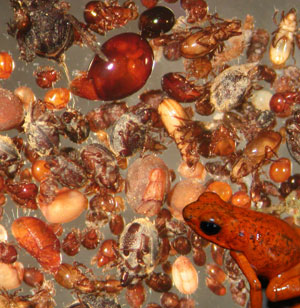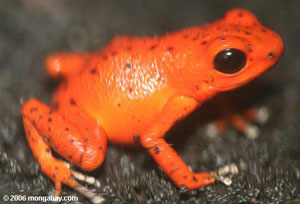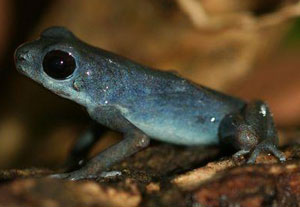Why poison dart frogs are poisonous
Why poison dart frogs are poisonous
Mites are the primary source of poison arrow frog toxins
mongabay.com
May 14, 2007
Mites — not ants as long believed — appear to be the primary source of toxins used by poison arrow frogs to defend against predators, reports new research published in the early online edition of Proceedings of the National Academy of Sciences (PNAS).
Poison dart frogs, colorful amphibians with skin secretions so toxic that they are used by indigenous populations to poison the tips of hunting arrows, are one of several groups of animals capable of sequestering deadly compounds from dietary sources without being harmed. Until now, it was believed that ants were the primary source of these defensive skin alkaloids in frogs.
Enter mites
Screening ants, mites, and other arthropods collected from the native habitat of the Central American poison frog Oophaga pumilio for various alkaloids, researchers led by Ralph A. Saporito, a biologist at Florida International University, found more than 80 alkaloids present in free-living, soil-dwelling oribatid mites. Of these toxic compounds, 42 were present in the skin glands of O. pumilio, suggesting that mites are the dominant source for frog poison.

A Costa Rican poison frog, Oophaga pumilio, is superimposed on a sample of leaf-litter dwelling oribatid mites, representing about two dozen species that were collected at a poison frog site (The scaling differs for the frog (~21 mm) and the mites (largest ~1 mm)). Such potential dietary prey contain a high diversity of alkaloids, many of which are found sequestered in skin glands of sympatric frogs. (Photo courtesy of R.A. Norton & M.A. Donnelly). |
“It turns out that mites are the primary dietary source of alkaloids,” Saporito told mongabay.com. “The dogma for years was that ants were the primary source. In fact, ants were thought to be evolutionarily significant to frogs, but now it turns out that mites are probably more important, certainly in terms of the number and diversity of alkaloids.”
The researchers also found 40 novel alkaloids in the mites that were not present in the frogs. Saporito says the findings may have shed light on the origins of toxicity for other frog species.
“Our research has implications for all poison frogs worldwide, including mantellids from Madagascar, certain bufonids from South America, and certain myobatrachids from Australia,” he explained. “Many of the alkaloids that we identified in mites are common to all poison frogs, in addition to Oophaga pumilio (the strawberry dart-poison frog).”
Overall, Saporito and colleagues found the range of alkaloids present in the skin of O. pumilio “echoes the variety found in mites at the same collection site,” indicating the importance of biological diversity for the chemical defense strategies of frogs.
“Reduced arthropod diversity or differences in arthropod diversity among locations likely affects the composition of alkaloids that are found in frogs,” Saporito explained. “It is possible that these differences may affect frog toxicity.”
The conclusion that poison frogs’ toxic alkaloids are derived from their prey explains why frogs reared in captivity lack the toxic defense of their counterparts in the wild. It also supports the observation that when poison frogs are introduced to non-native places like Hawaii their toxic alkaloids are different. Evidently, introduced frogs are feeding on different species of mites and ants which have their own set of alkaloids.

“Strawberry” and “blueberry” color forms of the highly variable Oophaga pumilio. Photos taken in Panama by Rhett A. Butler.
|
Saporito says that the findings may have implications for frog conservation efforts.
“Our work demonstrates the importance of conserving entire areas, taking into account the complexities of nature, rather than focusing only on certain species in a given area,” he said. “Chemical defense in poison frogs is a complex process that is dependent entirely on the local availability of certain arthropods, which can in turn be influenced by factors such as habitat alteration and disturbance.”
Clinical applications but disappearing opportunities
The alkaloids found in poison arrow frogs have applications beyond being a deterrent to frog-eaters. In the early 1990s, Abbott Labs began working with a frog toxin-derived compound for the treatment of pain. Abbott Labs eventually created ABT-594, a non-toxic, nonaddictive painkiller potentially effective for treating several types of pain. It is believed that other frog toxins could have curative properties as well.
The creation of ABT-594 almost didn’t happen. The area of Ecuadorian rainforest from which the frog was originally collected in 1974 was cleared shortly thereafter for banana plantations. Luckily, a second collection site still housed the frogs and scientists, led by John Daly (a co-author of the new PNAS study), were able to collect a sample of the poison which would later serve as the template for the painkiller.
The near miss with ABT-594 illustrates the importance of conserving biodiversity, especially in the tropics. Frog conservation is of particular concern given the recent worldwide decline in amphibians species. The Global Amphibian Assessment, a survey of the planet’s amphibian species, found that nearly a third (32%) of the world’s amphibian species are threatened while more than 180 have likely gone extinct since 1980. No one has yet pinpointed the ultimate cause for the demise of amphibians — global climate change appears to be worsening an epidemic of deadly chytrid fungal disease — but it is evident that opportunities are disappearing along with frogs. Some scientists worry that the global impoverishment of frogs — often viewed as the proverbial “canary in a coal mine” that indicate the relative health of an ecosystem — is only the first sign of more serious environmental problems. As they die, scientists are left wondering what plant or animal group is next.
Related articles
Bad news for frogs; amphibian decline worse than feared. Chilling new evidence suggests amphibians may be in worse shape than previously thought due to climate change. Further, the findings indicate that the 70 percent decline in amphibians over the past 35 years may have been exceeded by a sharp fall in reptile populations, even in otherwise pristine Costa Rican habitats. Ominously, the new research warns that protected areas strategies for biodiversity conservation will not be enough to stave off extinction. Frogs and their relatives are in big trouble.
Snake becomes poisonous by eating toxic frogs. A new study shows that the Asian snake Rhabdophis tigrinus becomes poisonous by sequestering toxins from its prey which consists of venomous toads. The research is published in the current issue of The Proceedings of the National Academy of Sciences.
Poison frogs may be less toxic when habitat degraded. Studying Mantella poison frogs on the island of Madagascar, a team of researchers led by Valerie C. Clark, a chemistry PhD student at Cornell University who earlier this year published a paper describing the origin of frog toxins as being the insects upon which they feed, found that frogs collected from intact forests “consistently have a greater diversity of insect-derived toxins accumulated in their skin than do frogs from disturbed and fragmented forests.”















